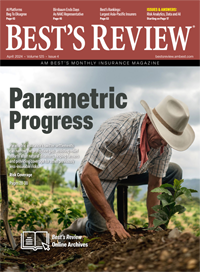Catastrophes
Hail, Wind and Fire: Extreme Weather Drives Up Rates for Renewable Energy Insurance
Insurers also are increasing deductibles and placing sublimits in policies.
- Marie Suszynski
- June 2021
-





As homeowners and commercial property insurance markets reel from an uptick in natural catastrophes and extreme weather, renewable energy projects such as solar and wind farms also are feeling the heat.
Hurricanes, hailstorms, intense thunderstorms and widespread wildfires can result in cracked solar panels or damaged wind turbines. Accordingly, premiums and deductibles have been on the rise, and insurers have tightened terms and conditions of their policies.
Members of the insurance industry say the correction was needed after a decade of a soft market with prices too low for profitability, especially as damage from weather events became more severe.

If you have 30% of your modules damaged, you’ll see less revenue from that project.
Michael Cosgrave
Renewable Guard Insurance Brokers
In the past, the insurance industry underestimated what a weather catastrophe could do to solar and wind farms, which are growing at a substantial rate every year, said Jamie Markos, U.S. renewable energy practice leader, Willis Towers Watson.
In 2017, Hurricane Maria destroyed all of the recently added solar panels on a solar farm in Puerto Rico, which produced 40% of the island's solar-produced electricity, according to a 2021 report from GCube, one of the largest underwriters of renewable energy.
In 2019, a hailstorm damaged 400,000 panels of a Texas solar farm and resulted in $70 million to $80 million in losses, GCube's report said.
Tornadoes have damaged rows of solar panels in New Jersey, Minnesota and Virginia. Wildfires have affected wind turbines in California.
“We're seeing weather events in parts of North America where we shouldn't be seeing those weather events,” said Fraser McLachlan, chief executive officer of GCube. The industry has seen tornadoes in California, hail in parts of the United States that traditionally don't suffer from hail, and flooding in places where it shouldn't flood, according to analytics.
Willis Towers Watson's 2021 Renewable Energy Market Review reported losses in 2020 ranged from more-frequent $1 million to $5 million events to one that could reach $30 million. Hail, wildfire, construction issues and problems with wind turbine generators contributed to recent losses.
Hail is particularly damaging to solar farms. When hail hits a solar panel, the damage isn't always seen instantly, said Michael Cosgrave, principal, Renewable Guard Insurance Brokers, which specializes in property insurance for renewable energy. Microcracks can occur, and they can propagate throughout the panel over a period of time.

We went out and said to our clients: ‘We have two choices. We can carry on the way we’re going and see more and more people exit the renewable insurance industry, or we can start making corrections to the book.’
Fraser McLachlan
GCube
In addition, a solar module expands and contracts as it heats and cools, which can cause microcracks to become larger. Over time, the panel degrades and doesn't produce electricity at an optimized level, he said.
“If you have 30% of your modules damaged, you'll see less revenue from that project,” he said.
A 2019 hail claim from a solar farm in Texas scared the market because of the size of the loss: $80 million, said Michael Perron, head of power, United States, Willis Towers Watson. The damage from the actual hailstorm wasn't huge but the equipment around the solar panels had to be replaced, which increased the size of the loss. Since then, insurers have been more careful about their exposure to hail and other storms.
Ice and snow also can damage wind turbines not made to withstand freezing temperatures. In northern states and Canada, the turbines are equipped with de-icing technology and built-in heating. However, in Texas, the turbines weren't winterized. Still, even when extreme cold weather moved into the state in February, the Solar Energy Industries Association reported that electricity output for renewables dropped only 1% between Feb. 13 and Feb. 16, while the output from thermal power plants went down 25%, Cosgrave said.
Wind turbines also can be vulnerable to lightning because of their height and the fact they're often the tallest structure in the area, said Carol Stark, U.S. Renewable Energy Practice leader for Aon.
Rates on the Rise
The insurance industry has responded to the higher claims with premium increases. Rates for renewable energy projects have increased every quarter for the last 14 quarters, in part because of natural catastrophes and extreme weather events, Cosgrave said.
Six to eight years ago, when property rates in renewable energy were in a soft market, rates were as low as 10 cents per $100 of insured value, he said. Today, they're potentially in the range of 30 cents per $100 of insured value—and significantly higher in catastrophe-prone states such as Texas and Florida.
Despite news reports that renewable energy projects are experiencing rate increases as high as 400%, Perron said most renewable energy clients aren't seeing spikes that high, although it's possible in certain pockets of the market. Some clients are seeing 40% increases, but most rate increases are much lower, he said.
Premium increases after significant events occur in almost every class of business, said John Andre, managing director, AM Best. Just as homeowners in coastal states will see increases after a hurricane, loss-affected businesses will experience rate increases.
Insurers also are raising deductibles and placing sublimits in policies. Sublimits set a maximum coverage for perils and have been expanded to include “soft cat” perils, which can include convective storms, hail, lightning and wildfires, Stark said. For example, if a solar farm with an asset value of $100 million has a claim not related to a weather event, the loss would be covered at $100 million. But if hail is sublimited, and there is a hail event, the insurer pays the sublimit, which is often only a portion of the asset value, such as $10 million or $15 million, after the deductible is met.
McLachlan's company set out in 2018 to make a “reset of the benchmark” after a decade of what McLachlan said had become an incredibly soft market as more companies entered the space.
But when natural catastrophes and extreme weather events led to increasingly frequent and higher losses, some insurers exited or curtailed their appetite for the space. According to Willis Towers Watson's review, Lloyd's syndicate Pioneer and CNA recently closed their specialty functions. Others, such as RSA and AIG, exited regional underwriting.
“We went out and said to our clients: 'We have two choices. We can carry on the way we're going and see more and more people exit the renewable insurance industry, or we can start making corrections to the book,'” McLachlan said.
Changes went beyond rates and deductibles. In the past, insurers took on 100% of a project's risk, but today they may take only part of the risk. Currently, McLachlan said, GCube may take on 5% to 50% of the risk of a project.
GCube and others also made changes to the terms and conditions of policies. In the soft market, insurance contracts took on the risk of manufacturers, contractors and subcontractors of renewable energy projects. McLachlan said GCube retracted from the market during that time because the terms weren't sustainable.
Less insurance capacity means renewable energy projects are having a harder time getting financing. Finance contracts require a conservative amount of insurance before approval. As a result, some renewable energy projects aren't being built, Perron said.
One way the market is responding to the changes in coverage is through parametric hail insurance. Long used for named windstorms and hurricanes, parametric insurance pays out after a measurable weather event occurs. Renewable Guard created a parametric hail insurance program that's triggered when a solar farm is hit with hail two inches in diameter or bigger, measured by 3D radar.
In developing the coverage, modules were shot with hail guns to test for damage, Cosgrave said. “The threshold is at a small enough diameter to make sure the policy triggers when hail is big enough to cause damage,” he said.
Parametric insurance covers the insured's deductible while supplementing their traditional hail insurance sublimit. Coverage can be blanketed across three or more solar project sites with $30 million of limits available. Renewable Guard is positioning its parametric hail insurance program as a replacement to traditional excess hail.
Parametric hail insurance can be an alternative to covering some of the soft cat perils and can bridge the gap between the sublimits or provide a coverage for losses within the deductible. Parametric solutions are provided by a number of carriers, including Swiss Re, Axa XL, Munich Re, and others, Stark said. More and more clients are showing interest in parametric insurance.
The future of the market depends in large part on the weather in 2021. Hurricanes rocked the market in 2017, hail came crashing down in 2019, and wildfires ripped through large swaths of the United States in 2020.
“What will this year look like?” Perron asked. “My sense is we're starting to see some initial responses from carriers showing they're being a little more malleable than the last six months.”
The more favorable market for insurers also is attracting new carriers to the space.
Axis Insurance, the specialty insurance business segment of Axis Capital Holdings Ltd., announced in January that it was expanding its global renewable energy business in Spain, Portugal and Latin America. Last year, Aegis said its renewable energy insurance initiative for property and casualty lines of business has grown to a portfolio of nearly $40 million in 2020.
New entrants could drive rates and deductibles back down a little, Perron said.
However, McLachlan said insurance rates have room to rise another 20% to 25% to get to where they need to be.



































